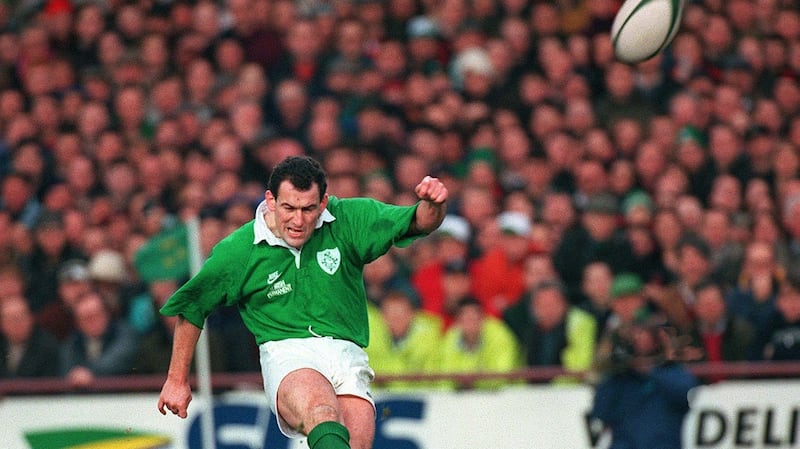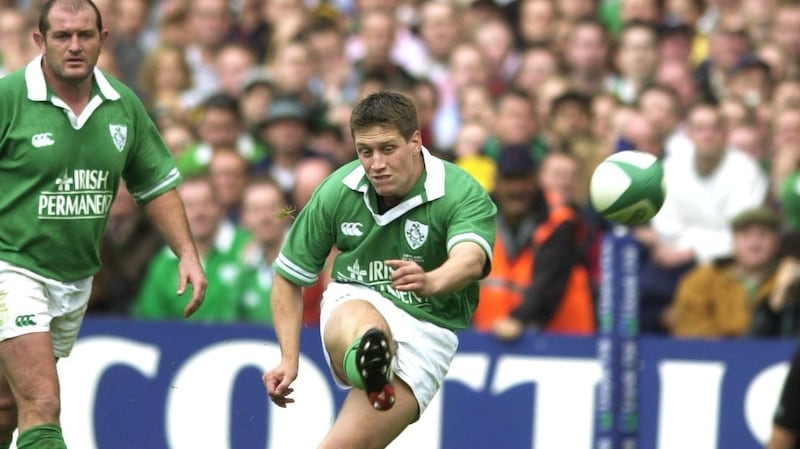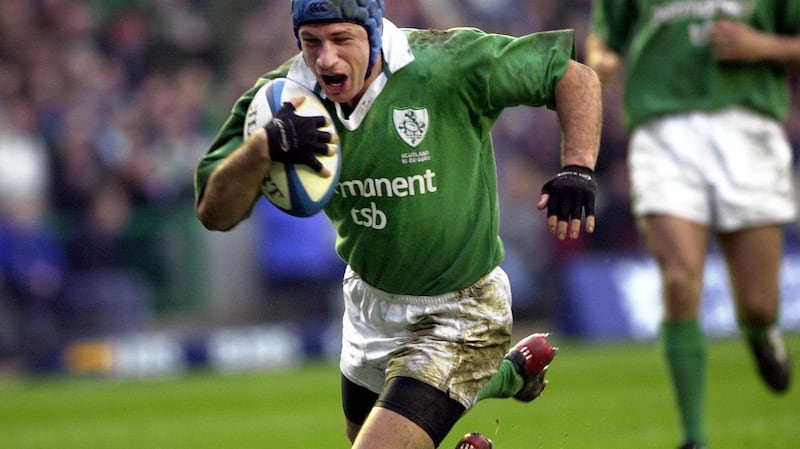Johnny Sexton wants to go on playing until the 2023 World Cup, when he will be 38, and it’s just as well that he still has the same desire and competitive nature that he’s always had. By the looks of things, Ireland still need him and, what’s more, may do so for a while yet.
With such a relatively small playing pool, history should have taught us to be grateful for the durability and longevity of our more evergreen performers, or should that be forever green? In any case, it was ever thus.
No less than at tighthead, where John Hayes, Mike Ross and Tadhg Furlong locked down the Irish scrum virtually unbroken for two decades, the system hasn’t exactly provided a conveyor belt of outhalves either.
Hence, likewise, the Irish international team has really only had three outhalves over the last two decades, namely David Humphreys, Ronan O’Gara and Sexton. In fact, go back a further seven years, and there’s really only been four in nigh on three decades.
Since Eric Elwood inspired a 19-14 win over Wales in Cardiff Arms Park on his debut halfway through the 1993 Five Nations, Ireland have played 131 games in the Five/Six Nations over 27 years. Of those, Elwood, Humphreys, O’Gara and Sexton have between them worn the 10 jersey on 123 occasions in that time.

Save for Paul Burke being handed the first two games of the 1995 Five Nations, the only other players to infiltrate this elite quartet have been Paddy Jackson (five starts) and Ian Keatley (one).
After Sexton sustained a grade two hamstring tear in the second round defeat at home by England in 2013, Declan Kidney surprisingly preferred the uncapped Jackson (then just turned 21) for the game away to Scotland, which Ireland lost. Kidney then dropped O’Gara altogether, preferring Ian Madigan on the bench as back-up to Jackson. Ireland drew with France, and then lost against Italy for the only time in Six Nations’ history.
So perhaps the moral of the story is not to be too hasty in jettisoning our veteran 10s.
Two years later, with Sexton on an enforced 10-week break due to concussion issues at Racing 92, Keatley started the opening win away to Italy in 2015 when scoring 14 points before being replaced by Madigan for the last 14 minutes. Sexton then returned for the last four games when Ireland retained the title.
Otherwise, that’s been it. One from Connacht, one from Ulster, one from Munster and one from Ulster. Like a game of roulette. Four outhalves in 27 years.
France would go through that many in a bad year.
Unused replacement
Fortunately, like the aforementioned trio of tightheads, the Irish 10s have stayed relatively injury free. One point of difference though has been that whereas Ross and then Furlong came along just in the nick of time for the baton to be passed on, the outhalves have sometimes overlapped, thereby creating a healthy rivalry and options for the coaches, both starting and during a game.
Humphreys vied with Elwood for four years and then with O’Gara for seven seasons, although after Humphreys was an unused replacement in the 2006 Six Nations, he announced his retirement from Test rugby a year out from the 2007 World Cup.
Paddy Wallace was O’Gara’s understudy for the next three years and won 30 caps over a six-year period, but never started at outhalf in the Six Nations or the 2007 World Cup, playing there in those competitions only three times off the bench, for a combined total of seven minutes.

Similarly, for much of the last decade Ireland have been heavily Sexton-dependant. Madigan started two games in the 2015 World Cup, including the quarter-final defeat by Argentina, and Jack Carty one game at last year’s World Cup, the defeat by Japan.
In truth, the IRFU, Joe Schmidt and now Andy Farrell have been unlucky in that Madigan chose to move abroad, Jackson was banished from Irish rugby and the anointed heir apparent and gifted Joey Carbery has been cruelly afflicted by injuries. Six of Carbery’s 22 Tests have been at 10, with six off the bench in the Six Nations and three off the bench in last year’s World Cup, since when he hasn’t played. If ever a player deserved a healthy and injury-free 2021, it’s him.
Speaking on BT after Jackson’s man of the match performance in London Irish’s homecoming win over Leicester in the newly-built Brentford Community Stadium – after 20 years in Reading – the former English and Leicester scrumhalf Austin Healy said: “Paddy Jackson’s control of the match was the difference.”
The presenter, Craig Doyle, then ventured that “if Jackson could turn back the clock and things had been different, he’d be starting for Ireland at the moment. He looks like an international flyhalf doesn’t he?”
“Yeah, he’s always got time on the ball, he’s always made good decisions, his viewing and scanning of the field is excellent, and then his execution of skills,” said Healy.
“He doesn’t seem to get rattled. In terms of his attacking play he’s quite happy to take tackles on the line and distribute the ball, but moreover he doesn’t always have to play what’s prescribed and his goal-kicking was spot on today, and not easy kicks. These are 45-metre kicks that he’s absolutely banging over.”
To fill these gaps, the recruitment of Billy Burns to Ulster may well result in him being next in line ahead of Ross Byrne at the 2021 Six Nations, while in the longer term Harry Byrne (21), Ciarán Frawley (23 yesterday) and the 20-year-old Jack Crowley, who looked a class act in last season’s Irish Under-20 team, all have the potential to emerge as Test outhalves. But they need more game time with their provinces.
We should also be grateful for the record-breaking partnership between Conor Murray and Sexton, who have been at the heart of nearly all of Ireland’s landmark achievements over the last decade. Irish rugby has never had a halfback partnership this bountiful and successful. Even Peter Stringer and O’Gara didn’t endure this long.
Boredom thresholds
But boredom thresholds are lower these days and one senses some of the rugby public have just grown tired of watching Murray and Sexton, even though they’re still the best in their respective positions.
Of course, competition is healthy. Like Peter O’Mahony, Murray responded positively to two games on the bench. Sexton is different though. He has more than enough inner desire and drive to motivate himself to be the best outhalf possible.
Even the dogs in the street know Sexton’s age now but Ireland’s attack coach, Mike Catt, for one, believes the Irish outhalf can keep playing good rugby at Test level for years to come. Catt helped England reach the final in his fourth World Cup at the age of 36 in 2007. At 37, when player-coach at London Irish, he also became the oldest player to play in a Premiership final and he didn’t retire until he was 39.
“Yeah, I went on until I was 39 so I understand what he’s going through. I think the big one for Johnny is that he is enjoying his rugby. He’s a huge figure within the team. He drives the standards. We all know what Johnny is about, but first and foremost I think each individual has to make sure that they perform themselves and he’s a big driver in that.

“He thoroughly believes in what Andy is trying to achieve or what we want to achieve as a group of coaches so everybody has been a proper buy-in and there’s nobody more passionate than Johnny when he puts on that Irish jersey.
“Again, depending on injury on everything that goes with it, sometimes it’s out of your control but at the moment where he is mindset-wise, he is very well capable, yes.”
The secret to Catt’s longevity?
“You become smarter. You avoid contact at all costs,” he quips. “I think it’s just the love of the game that drove me. I didn’t want to do anything else in life and I think Johnny doesn’t particularly want to do anything else. Johnny is all about rugby and he’s massively passionate about the game, about Leinster and about Irish rugby.
“If you’re in a good frame of mind, there’s no reason why you can’t carry on performing. But you have to perform. There are no excuses about it. If you’re not in form, you don’t get picked. You’re well aware of that and you understand that but it’s staying in a good place mentally. Because you’ve got all that knowledge and because you’ve got all that experience inside your head, the game becomes so much easier the older you get. So if you can keep yourself physically fit, you can go on ’til you struggle mentally, really.”
That doesn’t look like an issue for Sexton any time soon. Elwood, though discarded by Ireland at the age of 30, Humphreys and O’Gara all played until they were 36, and Sexton aspires to play on for longer. Hopefully he will too.












